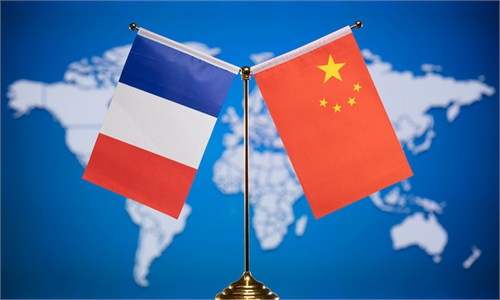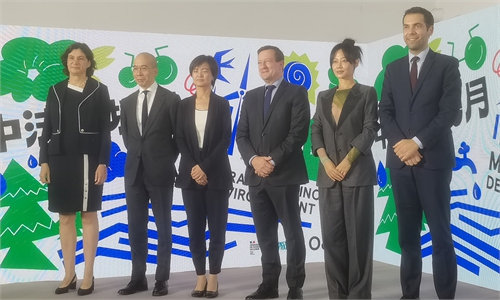ARTS / CULTURE & LEISURE
Chinese fashion designers innovate on traditional aesthetics for Paris show
Fusion on the runway
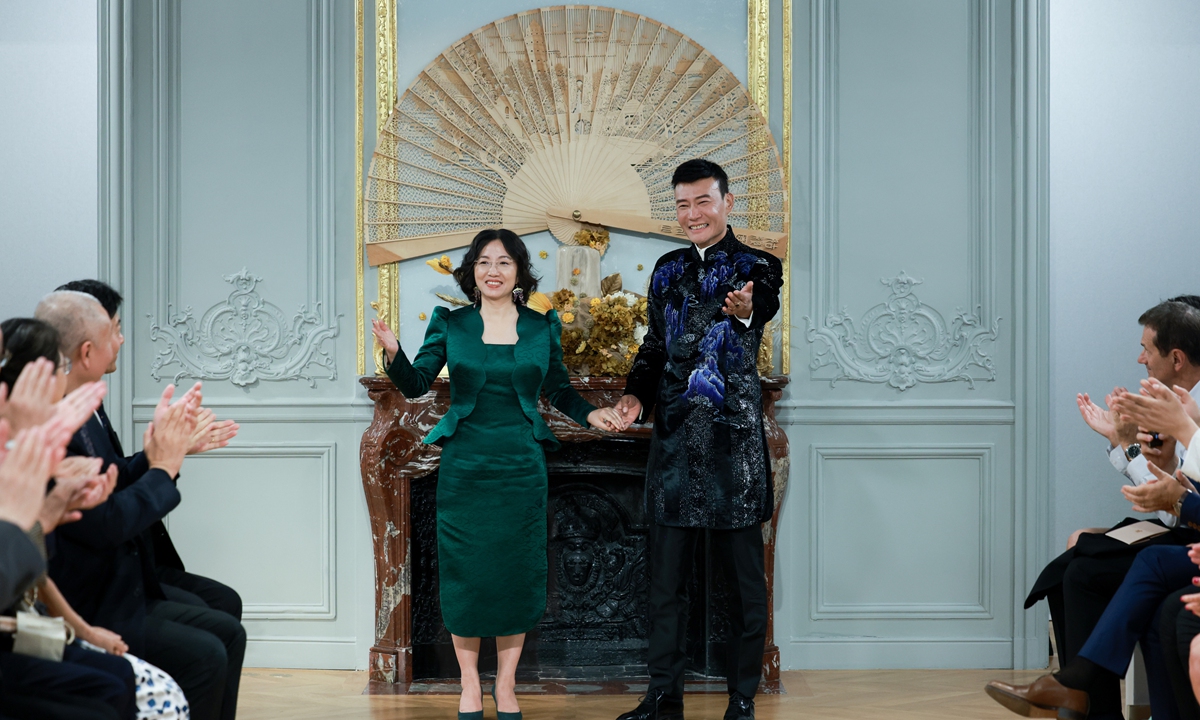
Fashion designer Laurence Xu (right) and Su Ning, deputy director of Prince Kung's Palace Museum, take to the stage during a fashion show in Paris. Photo: Courtesy of Xu's studio
Editor's Note:
How can art and culture from the past survive in today's globalized world? Inheriting a treasure trove of art and culture from the past thousands of years, young Chinese have created a new trend - Guochao, or China Chic. It refers to a movement started off by young Chinese who are endeavoring to revive and reinvent China's traditional culture.
These young China Chic trendsetters have helped China's cultural legacies be passed down and preserved for future generations.
In this column, the Global Times will interview young people who are using wisdom and creativity to reinterpret traditional Chinese culture in their particular field of expertise. The sixth installment focuses on the innovative Chinese fashion showcases on the Paris runway.
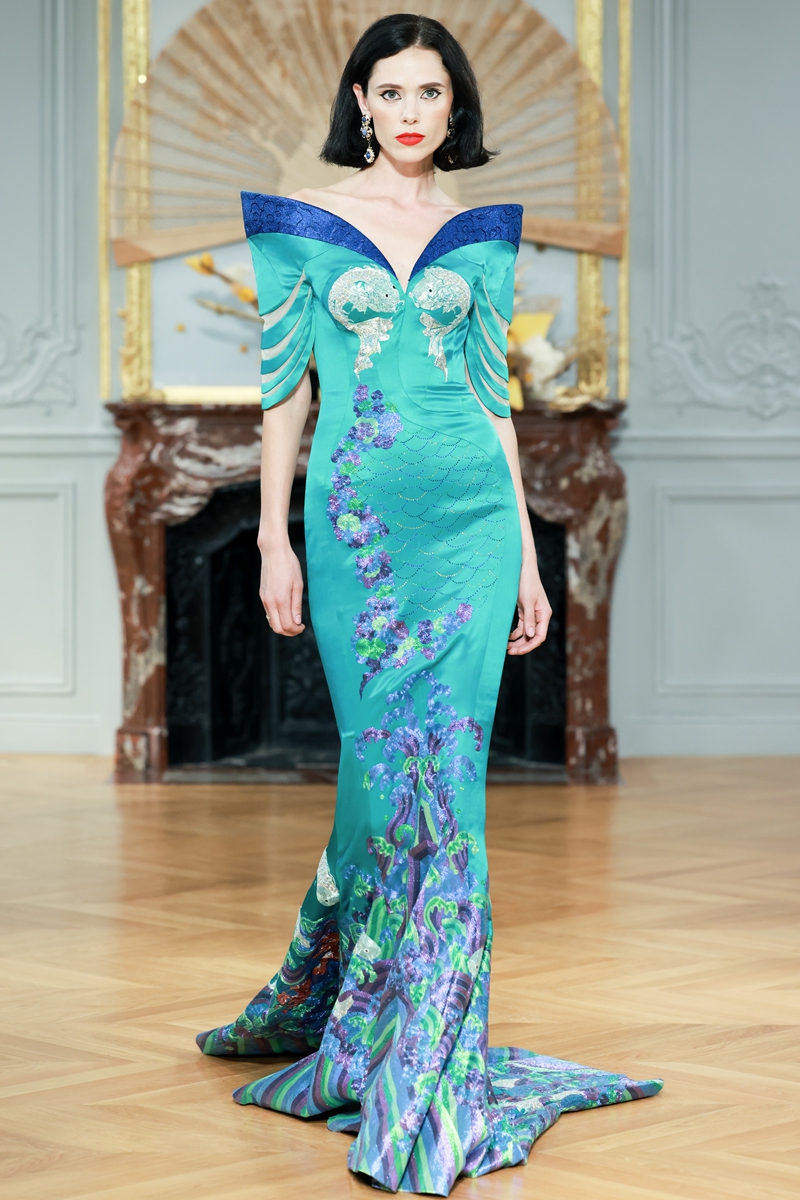
A model dressed in clothing designed by Laurence Xu walk on the runway in Paris. Photo: Courtesy of Xu's studio
Paris, the global epicenter of fashion, recently played host to the inaugural China-France Fashion Week, an extravaganza that saw a seamless fusion of Chinese and French design sensibilities.The event, jointly organized by the China Cultural Center in Paris and Beijing's renowned Prince Kung's Palace Museum, took place at the China Cultural Center in Paris.
Against the backdrop of melodic tunes, models strutted down the runway adorned in meticulously crafted ensembles that bore the hallmark of Chinese culture. The garments, often fashioned from natural materials sourced in China, combined signature Chinese craftsmanship with contemporary tailoring, creating a visual flair that drew fashion enthusiasts and the general public.
This fashion week is a crucial move to deepen China-France cultural exchange and cooperation in the realm of fashion, aligning with the specific measures outlined in the joint declaration to enhance collaboration in the cultural and creative industries between China and France, according to the introduction from the official website of the China Cultural Center in Paris.
The grand opening show of the event, presented by the Prince Kung's Palace Museum, marked the debut of the museum's cultural heritage brand in the fashion world. A total of 35 outfits, a collaborative effort between the museum and internationally acclaimed fashion designer Laurence Xu, graced the runway.
The theme of the show celebrated the rich legacy of the centuries-old Prince Kung's Palace by incorporating traditional cultural elements into clothing design. The fusion of Western structural cuts with classical Chinese designs and the use of exquisite Yunjin brocade, a traditional Chinese silk brocade, adorned with Miao ethnic and Suzhou Embroidery techniques, showcased meticulous craftsmanship and a contemporary expression of Chinese culture for global audiences.
"For the past two to three decades, we have been committed to showcasing Chinese culture, clothing, and memories on international stages worldwide," Xu told the Global Times.
As China transitions into a phase of high-quality development, the fashion industry and consumer preferences have been evolving, positioning Chinese brands to compete globally. The emphasis on creativity during the China-France Fashion Week served as a platform for Chinese brands to showcase traditional culture and their innovative designs to international fashion lovers.

A handbag designed by fashion designer Laurence Xu Photo: Courtesy of Xu's studio
Contemporary expression, intl disseminationPrince Kung's Palace, built in the 18th century, enjoys acclaim both domestically and internationally.
"Inspired by the traditional cultural elements of Prince Kung's Palace Museum, the show featured a harmonious blend of Chinese and Western design styles complemented by traditional heritage techniques," Su Ning, deputy director of the museum, told the Global Times.
"It also represents an active exploration and attempt by the museum in the contemporary expression of Chinese traditional culture," she noted.
During the fashion week, within the historic ambiance of the 19th-century Mendès France Mansion, 35 meticulously crafted high-end garments designed by Xu took center stage.
The collection drew inspiration from the traditional aesthetics at Prince Kung's Palace Museum, including its garden, ornate architecture, and cultural motifs like the revered Chinese character "fu" written by Emperor Kangxi (1654-1722) of the Qing Dynasty (1644-1911). "Fu" means good fortune or prosperity.
"Through creative transformation, traditional techniques are revitalized, contributing to the contemporary expression and international dissemination of outstanding traditional culture," Su said.
Xu showcased a luxurious golden cape that features gold-thread embroidery and various traditional techniques, including Miao ethnic embroidery, on the runway. An iconic red "fu" character adorned the back of the garment.
He explained that the red and green color palette of the collection mirrored the predominant hues of the palace; so many garments in the show are in red and green to create a harmonious fusion of cultural aesthetics.
Beyond the architectural characteristics of the museum, the designs also delved into its history. The extensive use of Nanjing Yunjin, a luxurious Chinese silk fabric, added a touch of opulence to the collection.
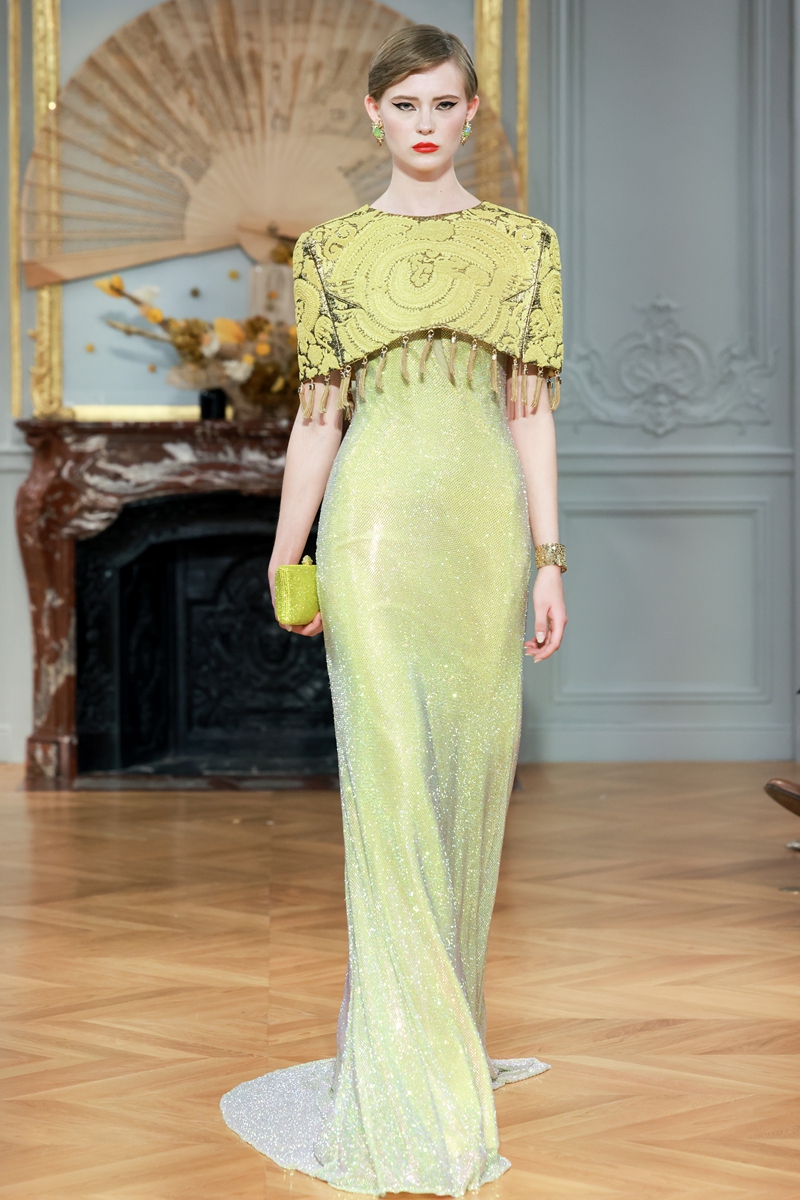
A model dressed in clothing designed by Laurence Xu walk on the runway in Paris. Photo: Courtesy of Xu's studio
Chinese formalwearAccording to Xu, Yunjin was popular during the Ming (1368-1644) and Qing dynasties, and so enhanced the garments with a distinct Chinese identity.
"Western formalwear designs tend to be more minimalist, with a prevalence of monochromatic ensembles. The grandeur and opulence of Chinese style may be uniquely understood and embraced by the Chinese. We are committed to blending Eastern and Western elements to better express the Chinese aesthetics, and many such works have been popular. This proves that Chinese aesthetics is not only national but also global," Xu noted.
During the fashion week, a down relief wall symbolizing China's rise was custom-built inside the modern hall of the Paris China Cultural Center exhibition. Two giant dragons soar and dance together, while traditional Chinese colors such as lotus root pink and sky blue jump out from the wall, causing many visitors to stop and take photos.
"This is my first time watching a Chinese fashion show, and I was really shocked. I was very happy to see the embroidery craftsmanship with a deep Chinese imprint shine on the Paris runway," said Chen Wenxiong, a former member of the French National Assembly and former deputy mayor of the 13th district of Paris.
"In France, 'silk' has a very deep connection with art and fashion. The China-France Fashion Week facilitated this 'reunion' of China and France around embroidery skills and silk art. Fashion is an important field for promoting cultural exchanges between China and France, and I look forward to more and better stages in the future," he noted.
This first-ever China-France Fashion Week attracted more than 400 participants from the fashion industries in both countries. The fashion week focused on the themes of "classic and innovation," "tradition and future," and "modern and intangible cultural heritage" in the hopes of inspiring more designers to incorporate Chinese culture into global fashion culture.
The fashion week was also held during Paris Fashion Week. Besides Xu as the main participating designer, many high-end collections from China also dazzled the audience.
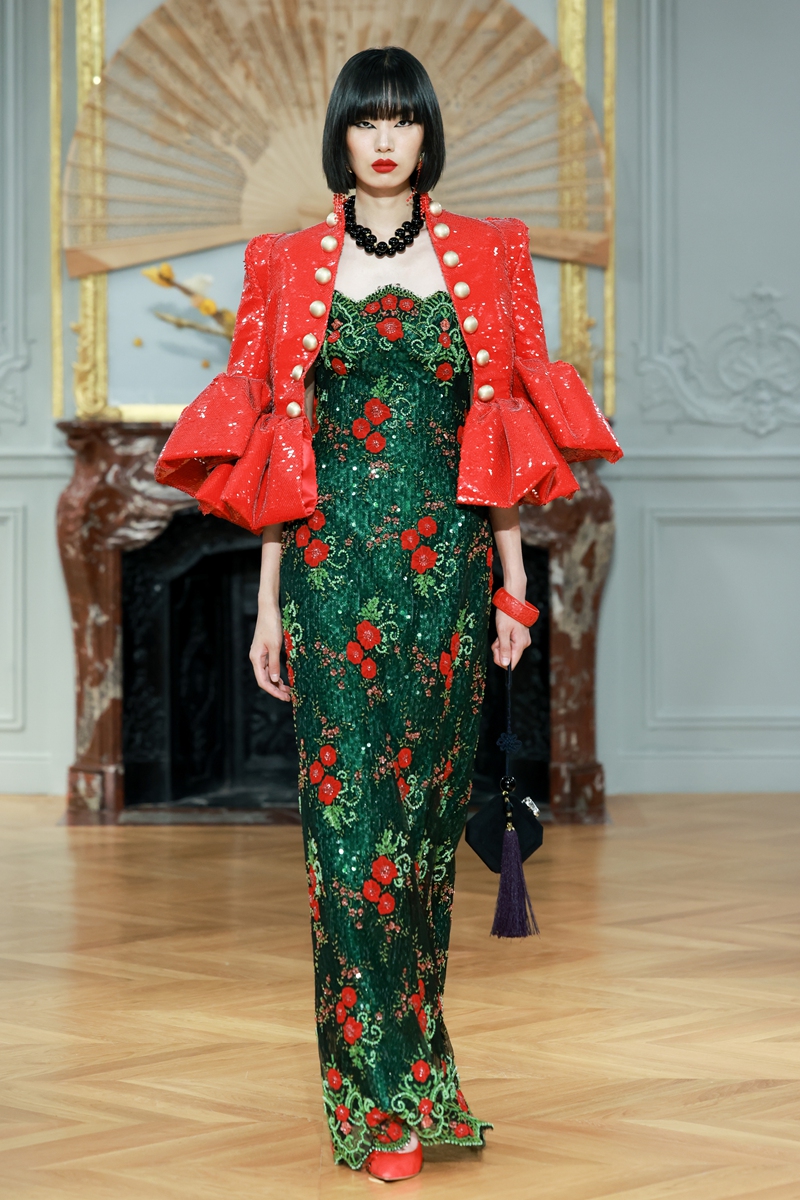
A model dressed in clothing designed by Laurence Xu walk on the runway in Paris. Photo: Courtesy of Xu's studio
Vast system of cultureThe Chinese high-end women's clothing brand NuNu&NoNo debuted its new season collection by Chinese fashion designer Zhang En. By using natural materials from China, combined with traditional craftsmanship, the haute couture brand's new season collection showcased a pure Asian philosophy and aesthetic worldview.
The designer drew creative inspiration from visual art and three-dimensional structuralism. The design of this season extracted blue, green, purple and red patterns from the sea.
In addition to colors and patterns, Zhang's clothing also had many highlights in terms of craftsmanship techniques such as prints, Guangdong Province embroidery, hand-crocheting and French embroidery.
In the collection, Zhang seeks to combine contemporary design elements with traditional concepts, incorporating intangible cultural heritage into fashion design, and using a variety of elements and fabric materials to appropriately match the cultural heritage of the fashion brand.
Yao Jianping, a representative inheritor of the national intangible cultural heritage Suzhou Embroidery, also released a series of high-end dresses in collaboration with a French brand. The collaboration was inspired by traditional and modern embroidery, and explored the clothing aesthetics of Asian poetry and Western classics.
For a long time, amid the rise of China Chic, many independent and chain brands have increasingly integrated traditional Chinese culture into their own creative designs, and the products they launched have also received continuous attention.
For example, Post-2000 clothing designer Yuan Qiqi once topped the trending list on China's social media platform Sina Weibo with his stunning design for US pop singer Beyoncé: a red cape with stunning shoulder pads inspired by the traditional wear of China's Yi ethnic group, worn for a photo shoot for the singer's album Renaissance.
Throughout his brief career as a fashion designer, Yuan has drawn inspiration from China's vast and diverse culture. Examples include the black and turquoise of Chinese inkwash landscape paintings, the large shoulder pads of the Yi people, and the famous Song Dynasty (960-1279) painting A Thousand Li of Rivers and Mountains.
Speaking about how the Yi people inspired him, Yuan recalled how one day he came across a well-liked short film on Douyin, featuring a number of elderly Yi men dressed in traditional attire.
"Since traditional Chinese culture is such a vast system, I used to believe that, as a young person, I was not equipped to take on this enormous duty of promoting traditional Chinese culture. But as time passed, I realized that the two don't contradict each other," Yuan told the Global Times.
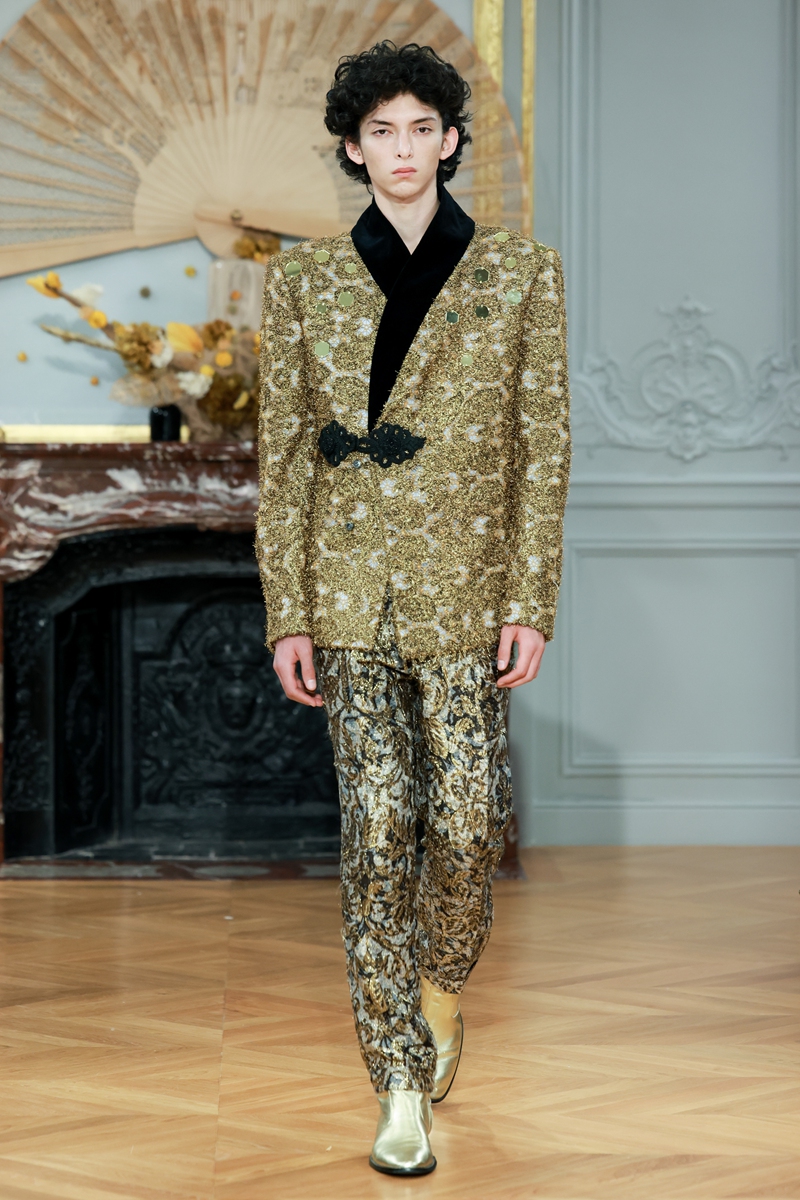
A model dressed in clothing designed by Laurence Xu walk on the runway in Paris. Photo: Courtesy of Xu's studio
